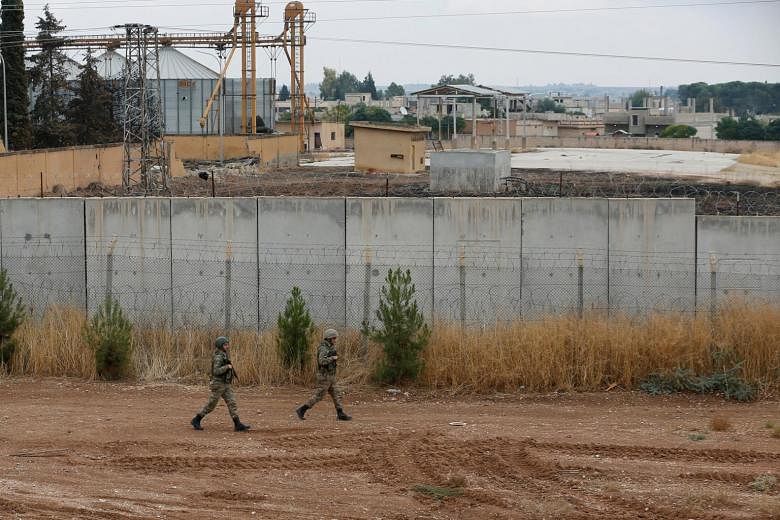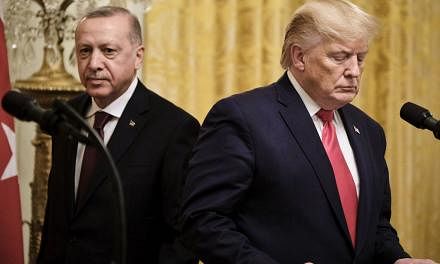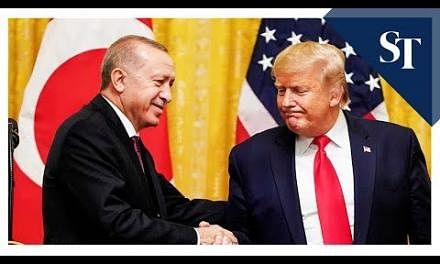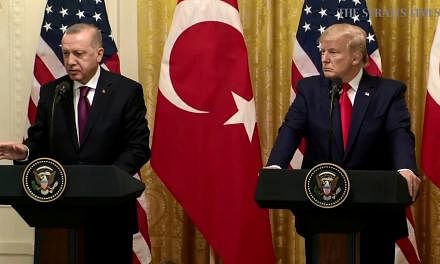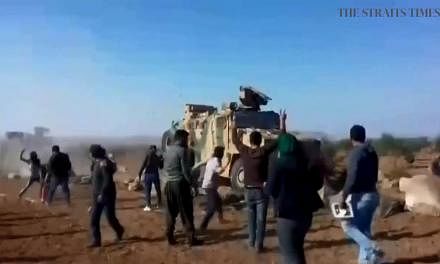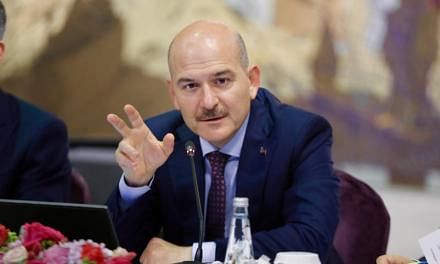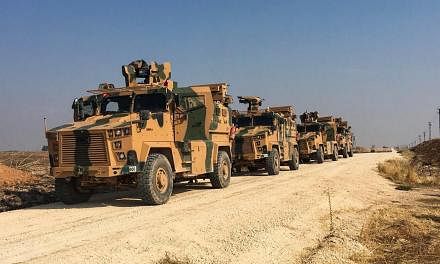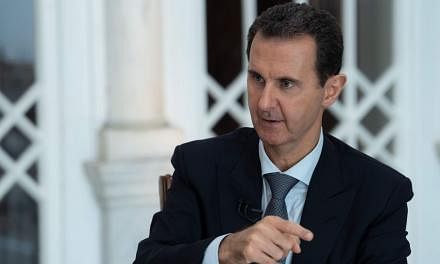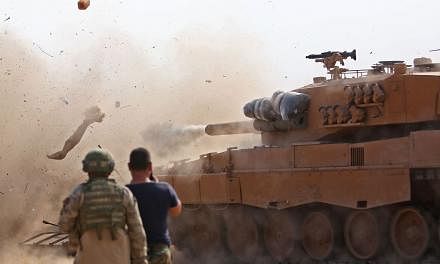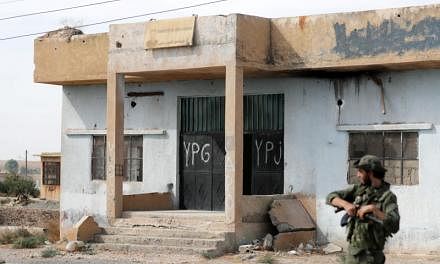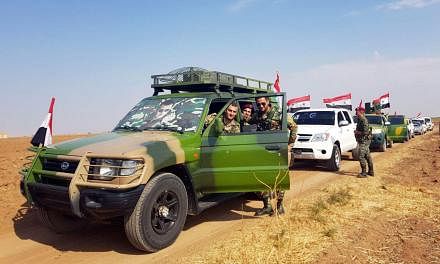DERIK, SYRIA (WASHINGTON POST) - As the final hours of a ceasefire in northeastern Syria wound down on Tuesday (Oct 29), dread descended on a region once shielded by the United States.
In towns and cities, families debated, and sometimes fought, over whether, and where, to run.
Selling their houses to pay for the help of unpredictable smugglers was one option. Moving closer to the Iraqi border, where thousands of refugees had already crossed, and then praying the violence wouldn't follow, was another.
"How do you decide what to do? Do we wait, do we leave?" asked a young student, Marwa, in the Syrian border town of Derik.
"There are no good options. None."
The end of the 150-hour ceasefire brokered by Russia threatened to reignite fighting that erupted after President Donald Trump decided earlier this month to withdraw US troops from the area and leave their Kurdish allies to fend for themselves in the face of a Turkish military offensive.
The temporary pause in hostilities also gave the various belligerents time to redraw the map of northern Syria and confront its residents with new realities and new risks.
As the mostly Syrian Kurdish fighters pulled back from the Turkish border, the Turkish military and its militia allies advanced from the north and Syrian government forces advanced from the south, retaking territory that had changed hands during the eight-year civil war.
The largely Kurdish communities of northeastern Syria feared both: their longtime Turkish adversaries and Syrian government forces that could view the locals as turncoats.
"The men feel strong, the women and children are scared, and no one knows what is coming," said Jawan, 34, standing in Derik's clothing bazaar, holding his nine-month-old daughter.
"This is bigger than us, really. America was meant to protect us, but that's done now. So I guess we'll just wait."
While US troops withdrew to the south and out of the area where they'd long kept the peace, Russian military police moved in.
Under an agreement reached last week between Russian President Vladimir Putin and Turkish President Recep Tayyip Erdogan, the Russian forces would now patrol the border.
At times, American and Russian armoured vehicles passed on the road, each with their own red, white and blue flags flapping in the wind.
Shortly before the ceasefire expired on Tuesday evening, Russian Defence Minister Sergei Shoigu said that a "full implementation" of the Russian-Turkish deal - which called for the Kurdish-led Syrian Democratic Forces to retreat from the border area - had been achieved.
The Russian Defence Ministry, citing Major General Yuri Borenkov, a senior military official working in Syria, said that 68 Kurdish units numbering 34,000 fighters had pulled back 30km from the border by Tuesday.
The only publicised withdrawal during the pause in Turkey's offensive took place on Sunday near the border town of Amuda, with the SDF waiting an hour for a Russian escort to arrive and lead the fighters south.
A group of children displaced from Ras al-Ayn, site of the worst fighting, had looked on. And civilians stopped their cars to ask what might follow.
"Give us good news," an old man implored Mustafa Bali, an SDF spokesman, clutching his hand.
Around the border towns of Ras al-Ayn and Tal Tamr, violence flared during the final hours of the ceasefire, suggesting that not all Kurdish fighters had withdrawn and that Turkish-backed troops were scrambling to seal control of the most contested areas.
Days earlier, as shells thudded in the background, a convoy of US trucks moved along the roads of northern Syria, transporting troops, equipment and the paraphernalia of what had once been a busy military base.
US Defence Secretary Mark Esper said on Monday that the US forces were being repositioned to secure oil fields in eastern Syria and make sure the Islamic State in Iraq and Syria (ISIS) could not gain access to them.
This redeployment was a pivot from Mr Trump's earlier statement that US troops were being sent home.
The shift in mission sewed confusion among the largely Kurdish forces and civilians.
"So they are leaving us for oil?" asked one man in a clinic on Monday, speaking on condition of anonymity because he said he now feared for his security if he spoke to American journalists.
"We heard for years that all America cared about was oil, but we didn't believe it, and we thought the Americans were our friends. Now what do we have left?"
After Mr Trump announced his decision to withdraw US troops, clearing the way for Turkey's military campaign, hundreds of fighters and civilians have been killed. About 200,000 people have fled their homes, according to the United Nations.
Mr Trump's decision marked a watershed moment in a long American effort to hold sway over parts of a Syria wracked by the eight-year conflict.
As a largely peaceful uprising gave way to civil war, Washington opposed President Bashar al-Assad's brutal, repressive tactics and supported an array of rebel groups.
But as ISIS rose and nationwide violence accelerated, northeastern Syria's Kurdish-led force had become Washington's favoured, and finally their only, partner.
Mr Trump's decision to pull US troops away from the region has set the stage for a major shift in power here, with Russians ascendant and the Syrian Kurds turning to Mr Assad's forces for protection from Turkey.
In a sign of how marbled the battlefield has become, Syrian government forces have returned to fighting on the front lines in northeastern Syria, and they have suffered a stream of casualties in recent days.
The Britain-based Syrian Observatory for Human Rights said that at least six Syrian government troops had been killed near Assadiya, south of Ras al-Ayn. There were also reports that the Turkish-backed force had kidnapped and executed another soldier.
At a medical facility in Hasakah, three soldiers lay wounded and riddled with shrapnel. One was unconscious and on life support. His facial features had almost been burned off, a doctor said.
Mostly young, local and poorly equipped, soldiers interviewed across two medical facilities said that they had been sitting ducks in the face of Turkey's heavy weapons.
"And we don't have heavy weapons, just these guns," said one Syrian government soldier, clutching a battered rifle.
He paced the yard at a Kurdish Red Crescent clinic in Tal Tamr while his friend was being treated inside for a gunshot wound to the chest.
The soldier watched as the latest ambulance pulled through the gates and medics wrenched open the door. It was another Syrian government soldier. The young man froze, then bolted to help.
"My brother, my brother," he cried. "What happened?"
